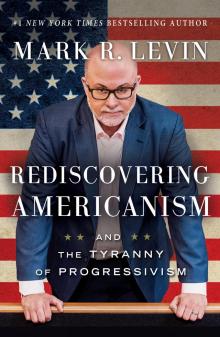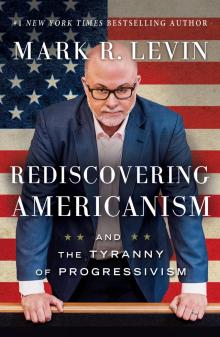- Home
- Mark R. Levin
Plunder and Deceit: Big Government's Exploitation of Young People and the Future Page 3
Plunder and Deceit: Big Government's Exploitation of Young People and the Future Read online
Page 3
Economists discuss the budget deficit in terms of its percentage of GDP. For most of the forty-plus years before 1998, federal debt held by the public was on average 39 percent of GDP.14 But when the unprecedented deficits that began at the end of the Bush administration exploded at the beginning of the Obama administration, and swelled further during the course of the Obama administration, the total amount of federal debt held by the public in 2014 rose to nearly 74 percent of GDP. Assuming that current laws remain in place—including the so-called Budget Control Act—federal debt will reach 103 percent of GDP by 2039.15 CBO’s long-term projections do not incorporate the negative economic impacts that are projected to accompany the government’s debt burden. When the economic impact is calculated, it is estimated that the debt burden will reach 111 percent of GDP by 2039.16 “Moreover, debt would be on an upward path relative to the size of the economy, a trend that could not be sustained indefinitely.”17
Increased public debt also means increased debt-servicing costs, particularly when the Federal Reserve eventually discontinues its artificially low interest rate policy. “When the Fed starts to raise interest rates, rising interest expenses to the Treasury is going to exacerbate the climb in the deficit,” according to economist Michael Englund of Action Economics LLC.18 The increase in interest payments by the federal government will consume a still larger portion of the federal budget, thus increasing the gap between remaining revenues and government benefits and programs.19 Interest payments are expected to more than double relative to the size of the economy—from 2 percent to 4.5 percent of GDP.20
Ever increasing federal spending exacerbates the national debt problem. For most of the past forty years federal spending has averaged 20.5 percent of GDP.21 But in Obama’s first year in office, federal spending spiked to 24.4 percent of GDP—the highest level since World War II.22 In both 2010 and 2011, expenditures were 23.4 percent of GDP.23 Even with sequestration cuts and follow-on budget deals, spending was 22 percent of GDP in 2012 and nearly 21 percent of GDP in 2013.24 CBO projects spending levels to increase to 26 percent of GDP by 2039.25 This is an immense increase in federal spending. It is attributable to two primary components: federal entitlement spending and debt financing. They are said to be “permanent” fixtures in the budget, which means both are supposedly beyond the reach of Congress’s annual budget process.26
Social Security and the federal government’s health-care programs—Medicare, Medicaid, Children’s Health Insurance Program, and subsidies related to Obamacare—will double in relative costs over the next several decades. For the past forty years they have together consumed on average 7 percent of GDP. However, they are expected to increase to 14 percent of GDP by 2039.27 Social Security, Medicare, and Medicaid account for 60 percent of the government’s noninterest expenditures in recent years, steadily growing as a share of annual federal expenditures.28 For example, in 1970 social programs accounted for 32 percent of total federal expenditures.29 Social programs grew to 44 percent of federal expenditures in 1980 and 1990, and 54 percent in 2000. They were promoted as safety-net programs for the protection of the poor, elderly, and vulnerable. But in each case the programs have snowballed and have become unsustainable. CBO expects their spending percentages to continue increasing indefinitely.30 Although this topic will be addressed more fully in a subsequent chapter, suffice it to say that the Social Security benefit cost explosion has been predicted for decades.31 There are currently 58 million people receiving Social Security benefits. By 2024 that number will grow to about 77 million, and by 2039 there will be 103 million eligible beneficiaries. Average benefits are on the rise as is the number of people qualified to receive benefits. Over the next ten years there will be a 38 percent increase in the number of people over sixty-five years of age and entitled to receive Social Security benefits.32 By 2039, CBO reports, there will be an 82 percent increase in the number of those who are over sixty-five years of age.
Increases will be caused, in significant part, by the influx of retirees and beneficiaries and the outstretched benefits promised by these programs, particularly with the huge expansion of federal health-care spending.33 Over the next ten years alone, the percentage of people reaching retirement age will grow from the current 14 percent to 21 percent.34 Concurrently, the number of income-producing individuals will drop from 60 percent to 54 percent of the population.35 CBO projects that trend to continue as life expectancy increases.36 Obviously, that means there will be fewer taxpayers available to pay the freight, a crushing burden imposed on younger people and future generations.
Again, although this will be the subject of a subsequent chapter, it merits mention here that federal spending on health care increased from 9.5 percent of GDP in 1985 to 16.2 percent of GDP in 2012. CBO projects that based on current trends the federal government’s health-care expenditures will mushroom to 22 percent of GDP by 2039.37 In order to pay for these ballooning expenditures, CBO forecasts that payroll taxes will grow significantly over the same time period,38 yet another enormous weight dropped on the heads of the rising generation.39
Not only is federal spending out of control, it is also inefficient and poorly monitored. A recent report issued by the comptroller general of the United States, Gene Dodaro, disclosed that duplicative or overlapping federal spending programs exist in 132 areas, from teacher training to job training.40 Dodaro also found that improper payments by eighteen different federal departments in 2012 cost the federal government a whopping $107 billion.41
In fact, so bad is the federal government’s management of its massive resources that the General Accountability Office (GAO) found the accuracy of most of its financial reporting suspect. In its latest audit of the federal government, the GAO concluded there are significant and material weaknesses in the accounting performed at all levels of the federal government. Among other things, it declared that this incompetence “1) hamper[s] the federal government’s ability to reliably report a significant portion of its assets, liabilities, costs, and other related information; 2) affect[s] the federal government’s ability to reliably measure the full cost as well as the financial and nonfinancial performance of certain programs and activities; 3) impair[s] the federal government’s ability to adequately safeguard significant assets and properly record various transactions; and 4) hinder[s] the federal government from having reliable financial information to operate in an efficient and effective manner. In addition to the three major impediments, GAO identified other material weaknesses. These are the federal government’s inability to 1) determine the full extent to which improper payments occur and reasonably assure that appropriate actions are taken to reduce them, 2) identify and resolve information security control deficiencies and manage information security risks on an ongoing basis, and 3) effectively manage its tax collection activities.”42
In fact, even the GAO and CBO understate the true nature of the economic and financial calamity facing the nation. On February 25, 2015, Boston University professor of economics Dr. Laurence J. Kotlikoff testified before the Senate Budget Committee about “America’s fiscal insolvency and its generational consequences.” He flatly stated that “Our country is broke. It’s not broke in 75 years or 50 years or 25 years or 10 years. It’s broke today. Indeed, it may well be in worse fiscal shape than any developed country, including Greece.”43 He condemned Congress for “cooking the books.” “Congress’s economically arbitrary decisions as to what to put on and what to keep off the books have not been innocent. Successive Congresses, whether dominated by Republicans or Democrats, have spent the postwar accumulating massive net fiscal obligations virtually all of which have been kept off the books.”44 Professor Kotlikoff explained that the real debt picture is far worse than the federal government admits. “The U.S. fiscal gap currently stands at $210 trillion. . . . The size of the U.S. fiscal gap—$210 trillion—is massive. It’s 16 times larger than official U.S. debt, which indicates precisely how useless official debt is for understanding our nation’s true
fiscal position.”45 “In 2013 the fiscal gap stood at $205 trillion. In 2014 it was $210 trillion. Hence, the country’s true 2014 deficit—the increase in its fiscal gap—was $5 trillion, not the $483 billion increase in official debt reported by the CBO.”46
Professor Kotlikoff concluded what should be obvious to all: “U.S. postwar generational policy is accurately characterized as ‘Take As You Go.’ Over the decades Republican and Democratic Congresses and Administrations have taken ever-larger amounts of resources from young workers and transferred them to old retirees. The resources taken from the young and given to the old were called, in the main, ‘taxes.’ And the young were effectively told, ‘Don’t worry. We are calling these resources taxes, but when you are old, you will receive massive transfer payments that more than make up for what you are paying now.’ ”47 Thus, there is a colossal transfer of wealth not yet created, by younger people and future generations, to the governing generation and generations since passed, which will doom America’s children and grandchildren if left unabated.
Moreover, the nation’s increasing debt burden will wreak havoc on the economy in very specific ways—higher interest rates, slower economic growth, weaker job markets, higher taxes, and higher inflation rates.48 The CBO notes that the enormous amount of government securities required to finance debt crowd out investments by individuals and businesses in the private marketplace, including in manufacturing, research, infrastructure, and small and large business opportunities.49 “Because wages are determined mainly by workers’ productivity, the reduction in investment would reduce wages as well, lessening people’s incentive to work.”50 In order to compete for investments, both government and private borrowers will face higher interest rates.51 While those rising interest rates will encourage individuals to save, the offsetting growth in interest costs will increase the cost of borrowing, thus further driving up the cost of the debt.52
The late Dr. Edward M. Gramlich, former Federal Reserve Board governor, explained that “For workers to become more productive, investments must be made in education and training; in modernized plants, equipment, and productive techniques; in new discoveries and innovations; and in transportation, communications, and other infrastructure. To make these investments, there must be a pool of savings that can be used for this purpose. Historically, the United States has had a particularly low rate of private savings, but, what is worse; the federal government’s deficit is financed by soaking up much of the savings we do manage to put away. When the government spends more money than it has, it borrows the rest. Most of the money borrowed comes from private savings.”53
Dr. Gramlich went on to warn that we cannot ignore the consequences of deficits much longer because they will lead to a stagnant long-term economy that will not only be unable to support Social Security, Medicare, and other social programs, but will not be able to provide opportunity for today’s youth who will be paying the bills.54
Professor Kotlikoff also points out that the impact of these policies has had another predictable outcome: “Older generations consumed more, younger generations had no or little reason to consume less, and the national saving rate fell.”55
A Moody’s Analytics analysis shows that workers under the age of thirty-five have gone from saving a small percentage of their incomes shortly after the 2009 recession to a current savings rate of negative 2 percent.56 In 2009, the savings rate for younger people was over 5 percent.57 A good rule of thumb is that a healthy savings rate is around 10 percent.58 Consequently, the very low savings rate among younger people is a sobering indicator of financial precariousness.
Debt accumulation—especially student loan and credit card debt—is a major contributor to the problem.59 Forty million Americans now have at least one student loan and in most cases at least four student loans to repay.60 Just six years ago, only 29 million Americans carried student loan debt.61 The average balance on these loans has also increased from $25,000 to $29,000 since 2008.62 Moreover, “[s]tudent loan debt has tripled from a decade earlier, to more than $1 trillion, while wages for young college graduates have dropped.”63 Fully 55 percent of those members of the rising generation with student loans are concerned that they may not be able to pay off their debt.64 And an alarming 43 percent have used nontraditional, high-cost forms of borrowing such as payday loans, pawn shops, and auto title loans.65
High credit card debt is another indicator of financial instability. Prior generations tended to incur credit card debt in their youth and pay it off once careers were established in middle age.66 But now, according to Ohio State University economics professor Lucia Dunn, “Millennials are not only going deeper into debt than earlier generations did at the same age, they are paying it off so much more slowly that they will die still owing money.”67 The tendency to make only minimum payments on their credit card balances suggest credit card debt for younger people will continue to grow well into their seventies.68
Many younger people have to delay major purchases of homes and automobiles; money is being diverted from retirement accounts; there are fewer business start-ups; and families are being delayed.69 Mark Zandi, chief economist at Moody’s Analytics, points out that over time the consequences are severe. “It’s not one of those things that matters a lot in a given year, but over a couple decades or generation or two, it matters a great deal.”70
According to a recent Pew Research study, younger people aged eighteen to thirty-two years old “are the first in the modern era to have higher levels of student loan debt, poverty, and unemployment and lower levels of wealth and personal income than their two immediate predecessor generations had at the same age.”71 The Census Bureau reports, in part, that “One in five young adults [eighteen to thirty-four years old] lives in poverty (13.5 million people), up from one in seven (8.4 million people) in 1980 and . . . 65 percent of young adults are employed, down from 69 percent in 1980.”72 What is more, in 1980, 22.9 percent of young adults were living with a parent deemed the householder; in 1990, the percentage increased to 24.2 percent; in 2000, the number dropped to 23.2 percent; but in 2009–2013, a record 30.3 percent were living at home with a parent.73
When confronted with this debt debacle, the statists’ usual and deceitful bromide is a demagogic appeal to income redistribution—that is, to demand higher taxes on “the rich” or a “more progressive” income tax where “everyone pays their fair share.” The fact is that if the federal government confiscated every penny produced by the private economy for the next decade, assuming a yearly average GDP of $20 trillion (today, it is $17.4 trillion annually74), in the eleventh year the aggregate national debt would still amount to trillions of dollars. In addition, the federal government’s own statistics, as analyzed by the nonpartisan Tax Policy Center, belie the class warfare, redistributionist agitprop. In the 2014 tax year, the top 20 percent of earners paid 84 percent of individual federal income taxes. Indeed, the top 1 percent of earners paid nearly half of the federal income tax. The bottom 40 percent of earners paid no federal income taxes. Even more, they receive federal government subsidies, including the Earned Income Tax Credit, amounting to tens of billions of dollars.75
Ultimately this is not merely about dreary yet didactic statistics but, as Dr. Williams insisted, it is about morality. The devastating consequences of wealth redistribution, intergenerational thievery, massive federal spending, endless borrowing, and unimaginable debt accumulation on American society, and most particularly on the ruling generation and future generations, are a travesty. Stealing from the future does not establish the utopia promised by the statists. It is the rising generation’s grave moral failure.
In his farewell address to the nation after serving two terms as president, George Washington urged his fellow citizens to “avoid . . . the accumulation of debt not only by shunning occasions of expense but by vigorous exertions to discharge the debts, not throwing upon posterity the burden which we ourselves ought to bear.”76
THREE
* * *
ON SOCIAL SECURITY
THE LARGEST SINGLE COMPONENT of the federal budget, and perhaps the greatest and most financially devastating burden imposed on younger people and future generations, is the Social Security program. This is not a recent development. Since 1993, it has outspent defense appropriations. As a percentage of federal spending, Social Security’s expenditures have ranged from 0.22 percent during World War II to 24 percent in 2013.1 And Social Security costs are actually skyrocketing.
Social Security has expanded from its original scope in 1935 to include workers’ dependents and survivors as well as the disabled. As a result, there are roughly 58 million people receiving benefits—more than double the number in 1970.2 As members of the ruling generation begin to retire, many more will be eligible for benefits. Unfortunately, there will not be nearly enough younger people working to pay the current rate of taxes to subsidize them. In 1940, there were 159 workers for every beneficiary. That ratio has dropped precipitously, from 16.5 in 1950, to 5.1 in 1960, to 3.7 in 1970 to slightly below 3 in 2010—and it is projected to get worse.3 There will only be 2.2 workers for every beneficiary in 2030.4
Social Security provides benefits through two major programs—Old Age and Survivors Insurance (OASI) and Disability Insurance (DI).5 Note the use of the word “insurance.” It is a fiction, about which I will elaborate later. The OASI program provides payments to retirees and, in certain circumstances, to their dependents; DI provides payments to people who are disabled and presumably cannot work. OASI and DI have separate “trust funds.” But for simplicity’s sake they are usually considered together when their financial viability is analyzed.

 The Liberty Amendments: Restoring the American Republic
The Liberty Amendments: Restoring the American Republic Rediscovering Americanism: And the Tyranny of Progressivism
Rediscovering Americanism: And the Tyranny of Progressivism Plunder and Deceit: Big Government's Exploitation of Young People and the Future
Plunder and Deceit: Big Government's Exploitation of Young People and the Future Men in Black: How Judges Are Destroying America
Men in Black: How Judges Are Destroying America Unfreedom of the Press
Unfreedom of the Press Ameritopia: The Unmaking of America
Ameritopia: The Unmaking of America Liberty and Tyranny
Liberty and Tyranny Rediscovering Americanism
Rediscovering Americanism Ameritopia
Ameritopia Plunder and Deceit
Plunder and Deceit